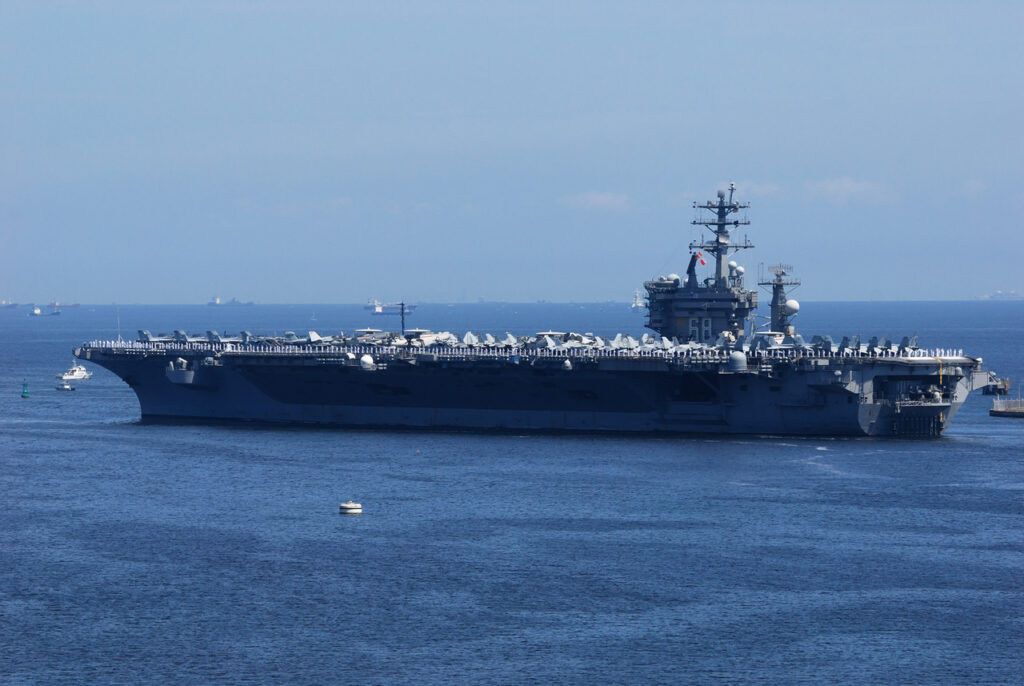
Navy Nimitz-Class Aircraft Carrier Was ‘Destroyed’ By Old French Submarine
What You Need to Know: In a 2015 wargame, the French Rubis-class submarine Saphir demonstrated surprising prowess by “sinking” the American supercarrier USS Theodore Roosevelt, highlighting vulnerabilities in the U.S. Navy’s anti-submarine defenses.

-Similar to the Swedish Gotland’s success against the USS Ronald Reagan in 2005, the Saphir’s stealth and agility allowed it to bypass the Carrier Strike Group’s defenses.
-While these incidents emphasize the potency of relatively humble submarines, they also underscore the challenges supercarriers face, particularly as smaller, low-cost threats like drones and missiles continue to evolve. The lessons learned will be critical for U.S. strategy in the Indo-Pacific.
The Navy’s Humbling Lesson: French Sub Defeats U.S. Aircraft Carrier in 2015
The American aircraft carrier is the most expensive and sophisticated warship ever built. Costing several billion dollars and hosting many thousands of sailors, the modern supercarrier is not supposed to be vulnerable to lesser, cheaper vessels.
At least not in theory. But as one relatively humble French submarine proved in a 2015 wargame, the American supercarrier is not invincible. Not nearly.

A Humbling Loss for the U.S. Navy
The 2015 interaction between the French Rubis-class submarine, the Saphir, and the American Nimitz-class submarine, the USS Theodore Roosevelt, would not have been a total surprise. The Saphir managed to “sink” the Roosevelt in the wargame, which on paper is a surprise, yes.
But the incident occurred just ten years after another similar incident, involving the Swedish Gotland.
In 2005, the Gotland successfully “sank” the USS Ronald Reagan during a wargame exercise. The Saphir incident ten years later was quite similar; the Saphir snuck past the Carrier Strike Group, which was defending the Ronald Reagan, and landed a fatal blow.
The Saphir incident, and the Gotland incident, served as harbingers for the problems the U.S. carrier force is facing in the Middle East today, where the relatively rag-tag Houthis are disrupting U.S. carrier operations with the deployment of low-tech drones and missiles.

The French Navy, of course, is not rag-tag. But the Saphir is hardly a machine with the scope or sophistication of a Nimitz-class carrier. So, the reality that the Saphir could cause significant harm to the Roosevelt was likely concerning, and embarrassing.
To contain the bad press, and the intelligence that would have encouraged adversaries like Russia and China, the U.S. Navy scrubbed the internet of the Saphir incident, hoping to contain the news about their deficient anti-submarine capabilities.
Rubis-Class Submarine A Lesser Adversary
The Rubis-class submarine is not exactly the adversary you would expect to “sink” an American supercarrier. At the time of the Saphir-Roosevelt wargame, the Saphir was already a thirty-year-old vessel, hardly a modern submarine. Smaller and lightly armed than most NATO submarines, the Rubis is not known for its destructive capabilities.
The Saphir was built with modest dimensions.
The length measures 73.6 meters, the beam 7.6 meters, and the draught 6.4 meters. By comparison, the American Ohio-class submarine measures 170 meters long. The Saphir displaces 2,400 tons and relies upon a pressurized water CAS-48 nuclear reactor, one electric motor, and one shaft auxiliary diesel generator. The propulsion system is capable of generating a twenty-five-knot max speed. The Saphir can operate at depths as deep as 980 feet. And like other modern nuclear-powered submarines, the Saphir can technically operate for twenty to twenty-five years at a time, although, the submarine is usually held to forty-five-day jaunts.
Hopefully, the Saphir incident allowed the U.S. Navy to gain valuable insights into their anti-submarine shortcomings. And hopefully, those insights led to reform. Because any future conflict in the Indo-Pacific will rely upon the survivability of the aircraft carrier.
About the Author: Harrison Kass
Harrison Kass is a defense and national security writer with over 1,000 total pieces on issues involving global affairs. An attorney, pilot, guitarist, and minor pro hockey player, Harrison joined the US Air Force as a Pilot Trainee but was medically discharged. Harrison holds a BA from Lake Forest College, a JD from the University of Oregon, and an MA from New York University. Harrison listens to Dokken.
Image Credit: Creative Commons and/or Shutterstock. Main image is of a Ford-Class aircraft carrier going throw a shock trial.


